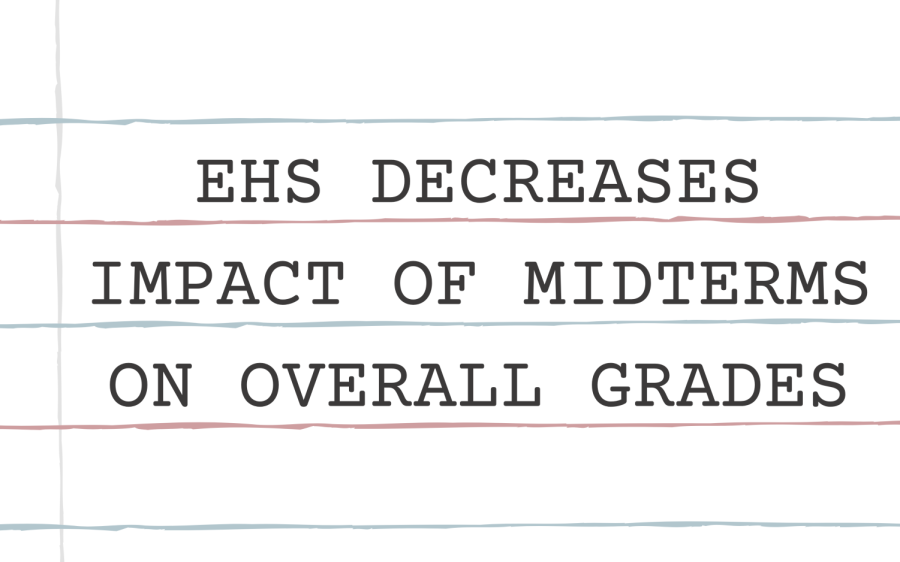EHS decreases impact of midterms on overall grades
January 5, 2022
This previously ran in our December 2021 print issue.
In the past, midterms and finals marked the transition from middle school to high school for many students. Most students have never taken tests with such high stakes before taking their first midterms in their freshman year.
For years, midterms and finals were taken towards the end of the second and fourth marking periods, each counting for 10 percent of a student’s grade. Together, the midterm and final were treated like a fifth marking period grade, and was averaged with the student’s four marking period grades to calculate a final grade for the class.
The last time that midterms or finals were held at Emmaus was in January of 2020. In the previous school year, largely due to COVID-19 and the fact that many students were learning remotely, midterms and finals did not occur.
When they were administered, each midterm lasted 90 minutes, with a 15-minute break between the first and second exam and a 50-minute break between the second and third exams so that students could eat lunch. Students did have to endure grueling tests, but there were some perks: students only needed to be in school for the periods that they had exams, so they were allowed to come to school late or leave school early if they did not have an exam to take during the exam periods. Even if students did have three exams during the day, they still had a shorter day and got to leave school at 1:00 rather than 2:25.
While midterms and finals were challenging for many students and it was fairly common for students to get a letter grade lower than their marking period grades on their midterms and finals, the tests were meant to help students by ensuring that they paid attention to class throughout the year and retained the information that they were learning. Plus, the tests helped students prepare for the academic environment of college, where the majority of a student’s grade will come from just a few tests or essays.
Some people, like senior Angelina Rizzotti, prefer this previous method of administering midterms because students had more freedom and time between midterms to take a break.
“I liked that we could go out; there was like a lot of time between your midterms,” Rizzotti said. “I used to go on walks, so that was cool.”
In addition, Rizzotti also enjoyed being able to get food from nearby restaurants, and she liked that she did not need to come to school during the periods that she did not have midterms.
With the new way of administering midterms during a regular school schedule, Rizzotti worries that it will be overwhelming for many students since they will be taking midterms during their regularly-scheduled classes.
“I think kids are going to be stressed more,” Rizzotti said. “…I would study between midterms, and we just don’t have that anymore.”
As with so many other things this year, midterms and finals will be different. This change was addressed in a Principal’s Newsletter sent out on Sept. 17, 2021. Instead of being treated as 20% of a student’s grade, midterms and finals will simply be test grades that count as a part of a student’s second and fourth marking period grades, respectively, and will be taken during regularly-scheduled classes. Information about exams for specific courses will come from the teachers of those classes, which suggests that teachers will have more freedom than in other years in determining how much midterms and finals will be worth for their classes.
Midterms will take place over four days: January 18, 19, 20, and 21. Students will take two midterms each day and their other two classes will cover normal material. On Tuesday and Wednesday, students will take midterms in their block one and block three classes. They will take their block two and block four classes on Thursday and Friday.
Additionally, students will not take English midterms this year.
In the Principal’s Newsletter from September, Dr. Kate Kieres addressed the reason for the change.
“Given the disruptions to learning last year, we wish to reduce the impact that these examinations have on students’ grades,” Kieres explained.
Nonetheless, she still believes that taking the exams are important, both for students and for teachers.
“It is still valuable for students to have the experience of taking cumulative exams, and also for teachers to gauge student learning using their results,” Kieres wrote.
While it could depend on specific teachers and how much they make midterms and finals worth for their classes, for many students this will be beneficial.
First of all, it will be easier logistically. Since midterms will take place during the regular school day, students will not need to worry about learning a different schedule for midterms or forgetting about which days and times they need to present in school in order to take exams, and they do not risk missing the exam or arriving 15 minutes late and being ineligible to take the exam due to a miscalculation of time.
Second and most important, not having 20 percent of their grade coming from two tests relieves a lot of stress and pressure from students. When midterms and finals are worth so much, people who do not take tests well or even just have a bad day could take a test that has a detrimental impact on their grade and not get a score that accurately reflects their level of knowledge on the subject.
With regular schoolwork, sports, clubs, jobs, and other obligations, students already are stretched to the limit. Many students spent the entirety of last year learning through Zoom, so they had to adjust to in-person school, as well as the many new safety policies to keep students and staff safe and the many scheduling changes that included the implementation of A/B block scheduling and Hornet Periods.
Switching the midterm to just a test grade that is counted in the second marking period will decrease the influence of the midterm on overall grades, even if teachers still decide to have it be worth more points than other tests in the marking period, and it will hopefully lead to students gaining the benefits of taking midterms and finals without so much of the nerves and pressure.
Business and Personal Financial Management teacher Anne Nero likes how the midterms will not interpret the flow of the school year.
“I like the inclusion of it into the marking period because it takes the stress off,” Nero said. “I think the scheduling will help keep all the courses on more of a continuum instead of breaking up and basically shutting down class before starting up again.”
However, Nero does recognize the new schedule may have some drawbacks.
“I think with anything, it’s going to be new, so it might be confusing for students. And I think if they’re given during the regularly scheduled class period, that it will be good for that class period [that the midterm is in], but it might not be good for the other class periods,” Nero explained. “Meaning, you just took a big test, and you have to go to a new period and learn something new. But, I guess it’s better than the old way where you didn’t have any other classes.”
Overall though, Nero is not sure how the new schedule will go and how it will compare to previous years.
“I feel like we won’t know until we go through it once and see how it runs and see how students handle it,” Nero said.











